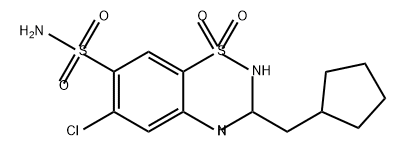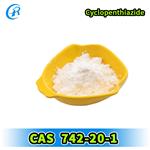
Cyclopenthiazide
- Product NameCyclopenthiazide
- CAS742-20-1
- CBNumberCB1295254
- MFC13H18ClN3O4S2
- MW379.88
- EINECS212-012-5
- MDL NumberMFCD00865825
- MOL File742-20-1.mol
- MSDS FileSDS
Chemical Properties
| Melting point | 230° |
| Boiling point | 605.6±65.0 °C(Predicted) |
| Density | 1.3650 (rough estimate) |
| refractive index | 1.6100 (estimate) |
| storage temp. | Refrigerator |
| solubility | Acetonitrile (Slightly), DMSO (Slightly), Methanol (Sparingly) |
| form | Solid |
| pka | 9.00±0.40(Predicted) |
| color | White to Off-White |
| Water Solubility | 50mg/L(room temperature) |
| CAS DataBase Reference | 742-20-1(CAS DataBase Reference) |
| FDA UNII | VX4S2N85F5 |
| ATC code | C03AA07 |
| EPA Substance Registry System | 2H-1,2,4-Benzothiadiazine-7-sulfonamide, 6-chloro-3-(cyclopentylmethyl)-3,4-dihydro-, 1,1-dioxide (742-20-1) |
| UNSPSC Code | 41116107 |
| NACRES | NA.24 |
Safety
| Symbol(GHS) |
 
|
| Signal word | Warning |
| Hazard statements | H302-H315-H319-H335-H373 |
| Precautionary statements | P261-P280-P301+P312-P302+P352-P305+P351+P338 |
| Toxicity | LD50 in rats, mice (mg/kg): 141.8 ±24, 232.4 ±25 i.v. (Barrett) |


